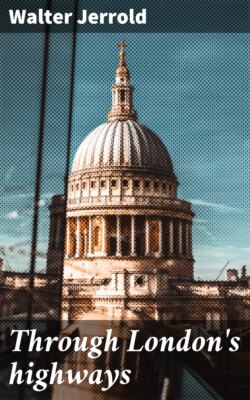Читать книгу Through London's highways - Walter Jerrold - Страница 4
На сайте Литреса книга снята с продажи.
I
ОглавлениеTable of Contents
“Why, how now, Babel, whither wilt thou build?
I see old Holborn, Charing Cross, the Strand,
Are going to St. Giles’s-in-the-Field.”
—Tom Freeman (1614).
Of all the many ways of getting to know a town or district there is perhaps none better than that which results from having the time, and inclination, to wander about and acquire the knowledge in a gradual and intimate manner. It is a method for which few but residents over a long period can obtain sufficient leisure, and they in the vast majority of instances lack the inclination. Maybe at the other extreme are those who, with a stentorian guide, are rapidly run round the place under review, and, with but the briefest pauses at the recognized “sights”, are shown everything in a few hours.
In the case of London it might almost be said that neither of these extreme methods is much good. Residents and visitors alike find London impossibly large in square mileage, impossibly crowded with things to be seen, traditions or memories to be recalled; thus it is that the resident is generally content to know, and that inadequately, the district or districts in which his social or business circle moves, and to have but a hazy view in regard to most of the remainder; while the visitor is mostly content to limit himself to certain “sights” selected in accordance with his individual taste, or on the plan of some guide. To visit the main buildings, parks, or monuments of a city, is only to see it partially. Indeed there are almost as many ways of “seeing” a place as there are visitors to see it. Visitors, however, may be divided into two vastly different classes: those who are content to be shown the “sights”, and those who have a desire to gain something of that more intimate kind of knowledge which comes of wandering about seeing the life of a city, and happening only from time to time upon the acknowledged “lions” of the locality. In the vast extent of London—which may be said to be represented by houses, houses all the way for a distance of some twenty miles from east to west, and somewhat about the same from north to south—there are so many objects of interest, 3 places of notable associations, or districts with their own particular “note” that it might well demand, as it has indeed been accorded, a library for its presentation in anything approximating to its literary entirety.
In its great system of motor omnibuses, London has what may be regarded by many people as the best means of seeing the externalities of the great city. By means of many interlinking routes, it is possible to get from wellnigh any point within the metropolitan area to any other point; and along the routes followed a goodly proportion of the “lions” may be glimpsed in passing, or paused at and visited, while a real knowledge may thus be gained of the relative positions of the astounding number of districts comprised within the vastness of London.
It is not surprising that some of the main starting-points of London’s motor-bus routes are found in the neighbourhood of the great railway termini—notably at Liverpool Street, London Bridge, and Victoria. Comparatively few people, it may be believed, start out to see London at the moment of their arrival; it has therefore seemed better to take radiating centres rather than railway stations as starting-points. In a necessarily brief survey of the incalculable mileage of her highways it is not easy to avoid at once the aridity of a mere directory of streets, the staccato 4 statements of a guide-book, and the undue emphasizing of certain places to the exclusion of others. London cannot be epitomized. Each of the centres which I have chosen might of itself provide materials for a volume many times the size of this.
By intersection and criss-crossing of routes it is possible, with but few changes, to get from any one point to another in the whole vast extent of a “Greater London”, which extends over close upon seven hundred square miles. That Greater London—the area within which the Metropolitan Police have jurisdiction—includes many places which the true Londoner still regards as being “out in the country”; here it is to the more central highways of the great metropolis that we must confine ourselves.
